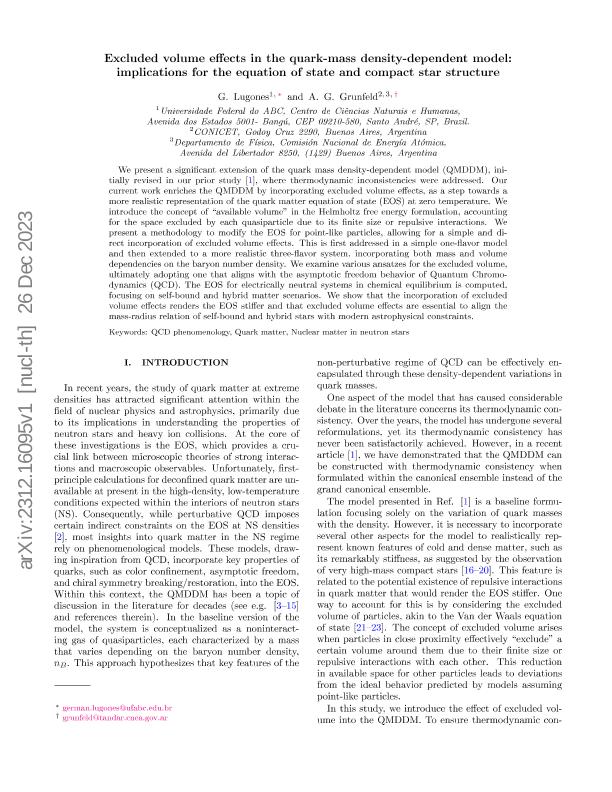Artículo
Excluded volume effects in the quark-mass density-dependent model: Implications for the equation of state and compact star structure
Fecha de publicación:
03/2024
Editorial:
American Physical Society
Revista:
Physical Review D
ISSN:
0556-2821
Idioma:
Inglés
Tipo de recurso:
Artículo publicado
Clasificación temática:
Resumen
We present a significant extension of the quark-mass density-dependent model (QMDDM), initially revised in our prior study [Phys. Rev. D 107, 043025 (2023)], where thermodynamic inconsistencies were addressed. Our current work enriches the QMDDM by incorporating excluded volume effects, as a step toward a more realistic representation of the quark matter equation of state (EOS) at zero temperature. We introduce the concept of “available volume” in the Helmholtz free energy formulation, accounting for the space excluded by each quasiparticle due to its finite size or repulsive interactions. We present a methodology to modify the EOS for pointlike particles, allowing for a simple and direct incorporation of excluded volume effects. This is first addressed in a simple one-flavor model and then extended to a more realistic three-flavor system, incorporating both mass and volume dependencies on the baryon number density. We examine various Ansätze for the excluded volume, ultimately adopting one that aligns with the asymptotic freedom behavior of quantum chromodynamics. The EOS for electrically neutral systems in chemical equilibrium is computed, focusing on self-bound and hybrid matter scenarios. We show that the incorporation of excluded volume effects renders the EOS stiffer and that excluded volume effects are essential to align the mass-radius relation of self-bound and hybrid stars with modern astrophysical constraints.
Palabras clave:
equation of state of dense matter
,
neutron stars
Archivos asociados
Licencia
Identificadores
Colecciones
Articulos(SEDE CENTRAL)
Articulos de SEDE CENTRAL
Articulos de SEDE CENTRAL
Citación
Lugones, G. ; Grunfeld, Ana Gabriela; Excluded volume effects in the quark-mass density-dependent model: Implications for the equation of state and compact star structure; American Physical Society; Physical Review D; 109; 6; 3-2024; 1-17
Compartir
Altmétricas




